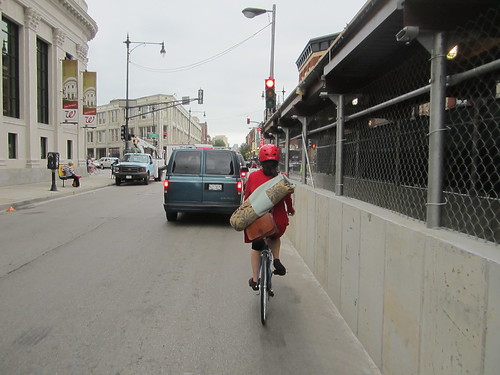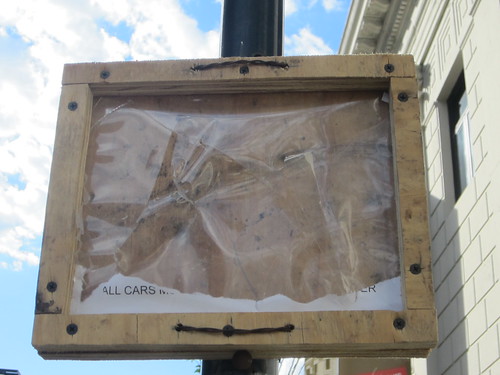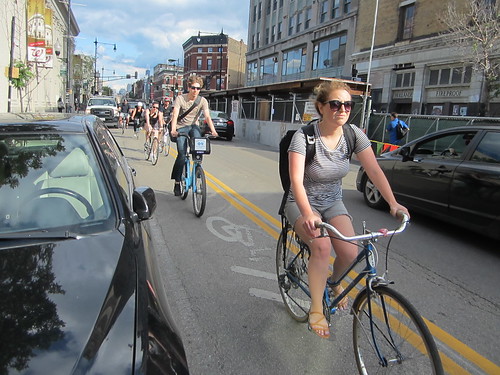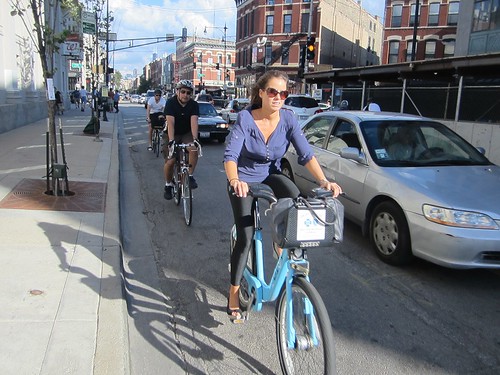On Thursday, Steven Vance and I got the news that the city was forcing a developer to fix a dangerous bottleneck on Milwaukee Avenue, Chicago’s busiest bike street, in Wicker Park. However, when I dropped by around 4:30 p.m. yesterday to check out the new street configuration, I found that the situation was as dysfunctional as ever.
In late June, Convexity Properties, a developer that’s turning the neighborhood’s iconic Northwest Tower into a hotel, built a pedestrian walkway in the street to protect people on foot while façade work takes place. The walkway’s exterior concrete wall narrowed the southbound lane of much of the 1600 block of North Milwaukee. As a result, southbound cyclists who tried to ride to the right of motorized traffic ran the risk of being squeezed into the wall.
Streetsblog Chicago writer Steven Vance brought the problem to the Chicago Department of Transportation’s attention. Last Thursday, a CDOT source told Steven that Convexity was not complying with the terms of its construction permit, which requires that both lanes of traffic be safely maintained.
CDOT would force the developer to pay for restriping the road’s center line to provide more room for southbound bike riders, Steven was told. Relocating the northbound lane east would require temporarily removing metered parking on the east side of the block, and Convexity would be responsible for compensating the city’s parking concessionaire for lost revenue.
Readers told us the work was carried out later that day. When I dropped by yesterday, the new yellow centerlines looked sharp. However, all of the paper "No Parking" signs, affixed to poles on the east side of the street, had been torn out of their wood frames and plastic lamination, presumably by disgruntled merchants or motorist. That side was still lined with parked cars.
The result was a chaotic scene. Northbound drivers were forced to straddle the new centerlines. To keep their distance from the oncoming traffic, southbound drivers were hugging the concrete wall, and southbound cyclists were still getting squeezed. Meanwhile, northbound bike riders were traveling in the tight space between the yellow lines and the parked cars.
When I asked a couple of motorist returning to their cars about the unusual street configuration, they said they hadn’t really noticed. However, cyclists I spoke to couldn’t believe that the city was allowing such a dangerous, anarchic situation to exist.
As if on cue, a Streets and Sanitation worker showed up and began tying new temporary signs to the posts. “You know why they tear the signs down,” he said. “They want to get away with parking there.” We both agreed that the paper signs probably wouldn’t stay up for long.
However, once he’d posted the signs and drivers, fearing tow trucks, stopped parking against the curb. About 15 minutes after the signs went up, the curb lane was almost empty, and the street was functioning the way it was supposed to. There was sufficient room for northbound motorists to stay east of the centerlines, and for northbound cyclists to share the lane with them. With more distance from oncoming traffic, southbound drivers kept their distance from the wall, giving southbound cyclists breathing room.
Of course, this relatively safe situation will only last until a selfish motorist or merchant tears down all the signs again. CDOT should require the developer to pay for bolting semi-permanent metal signs to the poles ASAP, before hazardous conditions caused by curbside parking lead to a serious crash.









